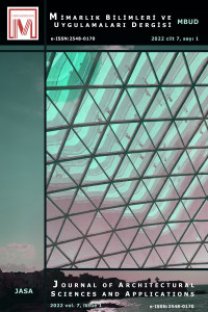Bina Yönetmelik Uygunluk Kontrolü Sürecinde Bina Projesine Ait Verilerin Gösterimleri
BIM (bina enformasyonu modellemesi), IFC (endüstri temel sınıfları), IFCXML, konut projesi, ACCC (bina yönetmelik uygunluk kontrolü)
The Building Project’s Data Representations in the Automated Code Compliance Checking Process
BIM (building information modelling), IFC (industry foundation classes), IFCXML, housing project, ACCC (automated code compliance checking),
___
- Aydın, M., ve Yaman, H. (2018). Bina enformasyonu modellemesi (bim) tabanlı bina yönetmelik uygunluk kontrolü literatürüne genel bir bakış. Tasarım + Kuram, 14(25), s. 59–77. https://doi.org/10.14744/tasarimkuram.2018.25744
- Aydın, M. ve Yaman, H. (2020a). Bina yönetmelik uygunluk kontrolü kavramına yönelik bir literatür taraması. Tasarım + Kuram, 16(29), s. 79–97. https://doi.org/10.14744/tasarimkuram.2020.86158
- Aydın, M. ve Yaman, H. (2020b). Domain knowledge representation languages and methods for building regulations. In: Ofluoglu S., Ozener O., Isikdag U. (eds) Advances in Building Information Modeling. EBF 2019. Communications in Computer and Information Science, Vol. 1188 CCIS, pp. 101–121, Springer, Cham. https://doi.org/10.1007/978-3-030-42852-5_9
- buildingSMART. (2020). buildingSMART International. https://www.buildingsmart.org
- buildingSMART Türkiye. (2019). buildingSmart Türkiye. http://www.buildingsmartturkiye.org/index.php/hakkinda/buildingsmart-turkiye
- Dimyadi, J., ve Amor, R. (2013). Automated Building Code Compliance Checking – Where is it at? Proceedings of the 19th World Building Congress: Construction and Society, 5-9 May, Brisbane, Australia, pp. 172–185.
- Dimyadi, J., Clifton, C., Spearpoint, M., ve Amor, R. (2014). Regulatory Knowledge encoding guidelines for automated compliance audit of building engineering design. Computing in Civil and Building Engineering (2014), pp. 536–543. https://doi.org/10.1061/9780784413616.067
- Ding, L., Drogemuller, R., Rosenman, M., Marchant, D., ve Gero, J. (2006). Automating code checking for building designs - DesignCheck. Clients Driving Innovation: Moving Ideas into Practice, pp. 1–16. https://ro.uow.edu.au/engpapers/4842
- Fenves, S. J., Garrett, J. H., Kiliccote, H., Law, K. H., ve Reed, K. A. (1995). Computer representations of design standards and building codes: US perspective. The International Journal of Construction Information Technology, 3(1), pp. 13–34.
- Graphisoft. (2018). ArchiCAD 21. https://www.graphisoft.com/archicad/
- Greenwood, D., Lockley, S., Malsane, S., ve Matthews, J. (2010). Automated Compliance Checking Using Building İnformation Models. Proceedings of the Construction, Building and Real Estate Research Conference, 2-3 September, Paris, France, pp. 363–371.
- IAI. (1997). Release 1.0 IFC Model Architecture. International Alliance for Interoperability. http://www.buildingsmart-tech.org/ifc/
- ISO_10303-11. (1997). Product Data Representation and Exchange Description Methods: The EXPRESS Language Reference Manual. ISO - International Organization for Standardization. https://www.iso.org/standard/38047.html
- Lee, H., Lee, J.-K., Park, S., ve Kim, I. (2016). Translating building legislation into a computer-executable format for evaluating building permit requirements. Automation in Construction, 71, pp. 49–61. https://doi.org/10.1016/j.autcon.2016.04.008
- Martins, J. P., ve Monteiro, A. (2013). LicA: a bim based automated code-checking application for water distribution systems. Automation in Construction, 29(23), pp. 12–23. https://doi.org/10.1016/j.autcon.2012.08.008
- Nawari, N. O. (2012). Automating codes conformance. Journal of Architectural Engineering, 18(4), pp. 315–323. https://doi.org/10.1061/(ASCE)AE.1943-5568.0000049
- Nawari, N. O., ve Alsaffar, A. (2015). Understanding computable building codes. Civil Engineering and Architecture, 3(6), pp. 163–171. https://doi.org/10.13189/cea.2015.030601
- NBIMS-US. (2015). National BIM Standard–United States Version 3. National Inst. of Building Sciences Washington, DC. https://www.nibs.org/news/242663/buildingSMART-alliance-Releases-NBIMS-US-Version-3.html
- Shih, S.-Y., Sher, W. ve Giggins, H. (2013). Assessment of the building code of Australia to inform the development of BIM-enabled code checking system. Proceedings of the 19th World Building Congress: Construction and Society, 5-9 May, Brisbane, Australia, pp. 1–12.
- Yayın Aralığı: Yılda 2 Sayı
- Başlangıç: 2016
- Yayıncı: Atila GÜL
Markov Tahmin Modelinin Testi: Isparta Örneği
Jesugbemi Olaoye AJİBOYE, Şirin Gülcen EREN, Andrew Ayangeaor UGESE
Covid-19 Pandemisi Öncesi ve Sürecinde Kentsel Yeşil Alanlardaki Sosyal İlişkilerin İncelenmesi
Mikro Konutlarda Sürdürülebilirlik Yaklaşımı
Deneyim Mekânları: Oyun-Öğrenme İlişkisi Çerçevesinde Vitrahaus
Merve KARAOĞLU CAN, Nuriye Nida ÇELEBİ ŞEKER
Türkiye'de Mekânsal Planlamada Veri Sorunsalı
Aybike Ayfer KARADAĞ, Demet DEMİROĞLU, Ayşe Esra CENGİZ
Can BALDAN, Ece KARACA, Yasemin AKCAKAYA
Bina Yönetmelik Uygunluk Kontrolü Sürecinde Bina Projesine Ait Verilerin Gösterimleri
Fenerbahçe Mahallesi Halkının İklim Değişikliğinin Kentsel Etkilerine Dair Farkındalıkları
Karaçi Kenti Ulaşım Sisteminin Sürdürülebilirlik Sütunlarının Analizi
